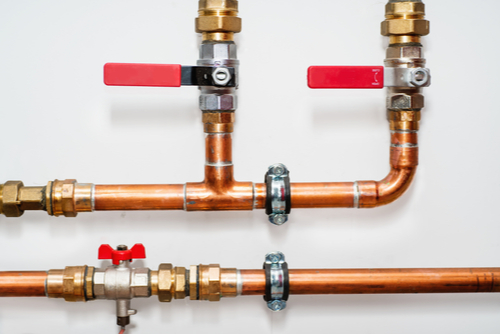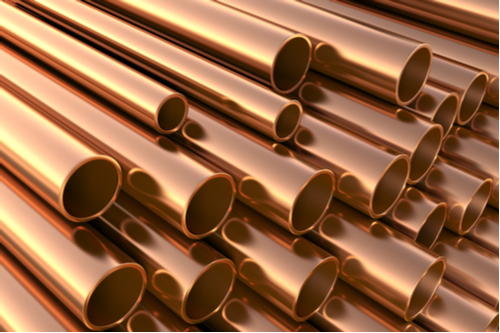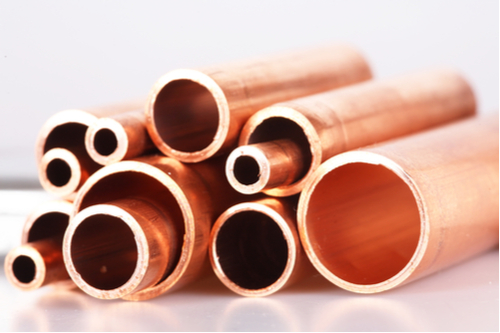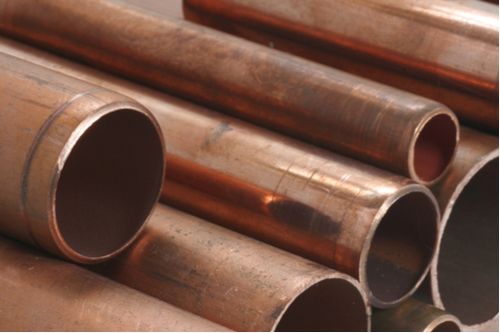Copper Pipe Design (MEP)
Copper lasts a lifetime with the least maintenance and service.
Copper pipes can suit a range of applications providing efficiency and performance.
Copper is a natural material and doesn't possess any threats or health risks.

Pipes are indispensable parts of various mechanical, plumbing, heating, cooling and water supply systems. Without pipes, the water will never reach where it's supposed to, making whole systems fail. When pipes are so important, it goes without saying that you would want high performance and reliable pipes for your home or building.
Among all types of pipes used in the industry, copper pipes have turned out to be the top choice. Copper has been used for centuries to distribute water- almost for 4,000 years! The Egyptians used it, the Romans used it, and now the whole world uses copper pipes since the 1940s.
It's not surprising that copper has emerged as the preferred material. Copper is durable, corrosion-resistant and reliable, making it ideal for a wide range of applications. Copper pipes never let you down and last for a lifetime with the least maintenance.
Everyone in the MEP industry can vouch for the superiority of copper over other materials without a second thought. Your building, construction or equipment will certainly benefit from copper pipes creating a resilient water supply system.
New York Engineers designs copper pipe systems for a plethora of applications encompassing residential, commercial and industrial uses. Our design services include domestic cold water and hot water supply pipes including hot water return lines. We also design supply and return copper pipes for condensers serving cooling towers, including industrial cooling towers. You can also rely on us for designing copper pipe systems for building heating water supply and chilled water supply.
Our team consists of skilled mechanical engineers who have years of experience working on projects of all nature and size. We used advanced digital solutions to design your pipes so that there is no room for errors. Our designs ensure that your systems and equipment get the needed supply of hot, cold or chilled water at the right time. If you need to design any kind of copper pipe for any application, then be sure to think of us!

It's not surprising that copper pipes have emerged as the most favorable option for water distribution systems. The material provides ample benefits and contributes towards a safe and efficient water supply system. Let's check out what makes copper so popular in the industry!
Long History of Reliability
Copper has been used for plumbing and water distribution for over 70 years. Around 95% of existing homes use copper piping while 80% new constructions also go for copper piping.
Copper pipes follow strict standards and are durable. The material is corrosion-resistant and doesn't crack or crumble even after long use. Copper pipes are also light and rigid and don't sag over long distances needing fewer supports. Cooper also makes room for secured joints and don't develop leaks like other materials. Copper is the only material that lasts a long time with virtually no maintenance.
Superior Safety
Copper is a natural material and doesn't need large emissions for manufacturing. You can also recycle copper, creating a lesser footprint on the environment. Copper also doesn't need solvents that come with volatile organic compounds, preventing air pollution and damage to atmospheric ozone.
Copper can also withstand high temperatures and don't burn or support combustion. That's why they are often used for fire protection systems and sprinklers. Fire temperatures can reach 1,500-degree Fahrenheit and still copper will not melt. The material is also non-permeable and doesn't absorb contaminants.
Healthy
Copper pipes are the most healthy choice when it comes to domestic and potable water supply systems. Copper has special abilities to reduce the risks of diseases from waterborne bacteria. Studies have shown that certain bacteria and viruses such as Polio Virus, E-coli O157, and Legionella Pneumophilia are inhibited by copper piping. It is also ten times more effective than PEX at fighting Legionella Pneumophilia which causes the Legionnaires' disease.
Copper also doesn't leach into the water like other materials. For water left overnight in copper pipes, only 0.6 mg of copper was leached per liter- well below the World Health Organization (WHO) recommendations.
On the other hand, materials like PVC leach into water and can cause damage to liver, kidney, immune system and nervous system.
Withstands Extreme Conditions
Copper can withstand extreme conditions handling more than 1,000 pounds per square inch of pressure. You can also use it outdoors without worries as copper can resist natural forces with ease. The material can also be suited for industrial applications where pipes may come in contact with chemicals and toxic liquids.
Copper can also handle repeated freeze-thaw cycles and heated to melt frozen water.
High Thermal Conductivity
Copper is eight times more effective in conducting heat compared to other materials. Copper Copper's high thermal conductivity is advantageous for many applications like geothermal pump systems, radiant heating, direct exchange, snow melting and more.
has the best heat conductivity among copper, steel and aluminum. That's why it is ideal for applications like solar power where a thin sheet of copper can accumulate the same amount of heat as thicker-gauge steel or aluminum sheet. The thermal conductivity also makes copper pipes suitable for home plumbing as frozen water is easy to melt.
Value for Money
Copper pipes may cost a bit more up front than non-reliable materials, but makeup with the value it provides for years to come. You can even set up your copper pipe system in lesser final cost than cheaper materials.
Copper enables you to save cost, time and effort through easy handling, forming and joining. You will also need less maintenance and repairs over the years. In the end, you will be able to make considerable savings and also increase the value of your property while selling.
Long Lasting
Copper can outlive the building where it is installed by many years. Light, strong and corrosion-resistant copper pipes last for a lifetime and you don't even need to take any special precautions. Copper provides peace of mind resulting in customer satisfaction and universal acceptability.
Copper pipes also comply with major building, plumbing and mechanical codes and offer a safe and reliable system for water, gas or liquid distribution.

Copper pipes come in different sizes and types to suit specific applications. Generally, three common types of copper pipes are used for most purposes- Type K, Type L and Type M. You may also find another type of copper pipes, called DMV or drain-waste-vent mostly in older buildings. Copper pipes can either be made rigid or soft. The type of copper pipe you need for your application will be determined by the internal or external fluid pressure, installation method and local code implications.
Type K Copper Pipe
Type K pipes are commonly used for applications such as water supply, HVAC, fire protection, oil and more. Type K comes with the thickest wall size among all pipes and is either rigid or flexible in construction. This type of copper pipe is ideal for burial and often used for underground water distribution. The pipe is also durable enough to withstand the load of soil used to cover the pipes.
It is not recommended for use with natural gas as the pipe joints can get damaged. Type K copper pipes can withstand considerable pressure, up to 1,466 pounds per square inch at 100-degree Fahrenheit.
Type L Copper Pipe
Type L copper pipes are suitable for fire protection, interior plumbing and HVAC systems. You can find both rigid and flexible forms of Type L pipes which can be used with flare, compression and sweat fittings. Type L is a versatile pipe used in far more applications compared to Type K copper pipes.
Flexible Type L copper pipes are ideal for repairing or replacing old water lines and can be used outdoors for above ground applications. Type L copper pipes have a thinner wall than Type K, but thicker than Type M. At 100-degree Fahrenheit, Type L copper pipes can withstand 1,002 pounds per square inch of pressure.
Type M Copper Pipe
Type M copper pipes are commonly found in residential water service and vacuum systems. Type M has a thinner wall compared to both Type K and Type L copper pipes and available in rigid and flexible constructions. Like Type L, it can also be used with compression, sweat and flare fittings.
Type M pipes are the most economical among the three types and preferred in domestic application for their affordability. But Type M may not be allowed by all jurisdictions so it's better to check with your local codes first.
DMV Copper Pipe
DMV copper pipes were traditionally used in old buildings for plumbing drains and vents. DMV pipes have a low pressure capacity of 10 to 15 pounds per square inch and suitable for above the ground applications. The pressure rating of DMV pipes is lower than the standard municipal water supply pressure.

Copper pipes are known by their nominal size than actual measurements. The actual outside diameter (OD) is not the same as the pipe size. For example, a 1/2 inch copper pipe comes with an outer diameter of 5/8 inch. That means the outside diameter is always 1/8 inch larger than the nominal size of the pipe. All types of copper pipe follow this principle.
The inside diameter (ID) of a copper pipe varies and is calculated based on the thickness of the wall. Schedule number of pipes refer to the wall thickness and are standard for copper pipes. You can have different schedules like schedule 10, 20, 30, 40, 80, 10, 160, XX, XS and so on.
We can help you choose the right size and type of copper pipes based on your needs and circumstances.
New York Engineers is a leading plumbing and mechanical piping system designer with experience of working on several domestic, commercial and industrial projects. We use copper pipes for all its advantages and create a foolproof water distribution system for buildings and systems. We can design copper piping systems for a range of applications including but not limited to-
Get in touch with us to discuss how to go about designing your copper pipe system. Our engineers are eager to provide their adept service and help you execute your project successfully.